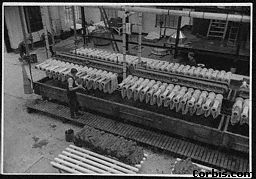Flax & Linen in Roe Valley

In the
the Limavady region (Roe Valley), flax was grown locally by Farmers, whospun
the yarn, themselves. Which was then sold to the weavers. (See the LinenMill
picture from Northern Ireland)
Waterpower was first used in the bleaching process, and then later powered
Wash mill and Beetling Shed in the early 18th Century. There were around
ten bleach greens still running in the early 19th century.
The centre of the Linen Industry in the Roe Valley was at the Dogleap, where
the first organised Linen bleaching began around 1760. The areas of woodland
around the Roe including the Dogleap, are now the Roe Valley Country Park.
During a walk from the visitor centre at the Dogleap, the Largy Green and
watchtowers near the river can be seen. The remains of the old mills andthe
beeting shed can be seen. Not much is left of the once thriving LinenIndustry
at the dogleap, but ruined buildings and no Linen bleaching to beseen.
The Weaving Shed at the Dogleap, which has been restored,
and is now a museum. One of the pieces is an old flax machine, used for breaking
flax. Both the Beetling Shed and Weaving Shed
were water powered, you can still seen the mills races around theDogleapand
the Country Park. Machine scutching (crushing and breaking toremovethe fibre
from the woody fragments of the flax stems) of flax usingwaterpower became
common in the Limavady area from the mid 1700s.
For much of the 18th Century, the spinning of linen yarn
was much more important than weaving in the north western economy. The yarn
was exported mainly to Lancashire, England. As this market crumbled,
clothmanufacture expanded.
In 1771 Marcus McClausland had received the Corporation's
approval to build a Linen Hall in Linen Hall Street (formerly known as Cross
Lane). By 1784, Limavady trading of brown Linen was already good, the twenty
years that followed saw brown linen
sales doubling in the North-west of Ireland.
The downfall of the linen industry in the Roe Valley was
forced by the unusual low price of cotton and the increases in machine spun
linen. It was by no means the end of the industry, flax
continued to be grown and scructed in the Limavady region well into
the 20thcentury. In 1870 a tow-spinning factory was set up at the Carrick
Mills.
In 1865, the Limavady Spinning and Weaving Company was established,
using stream power, it made both fine damasks and coarser linen until 1933.
The Weaving factory occupied the present site of Alexander Road housing
estate,which was built in 1971. As employment decreased in the linen trade,
shirtmaking was introduced as a cottage industry.
|